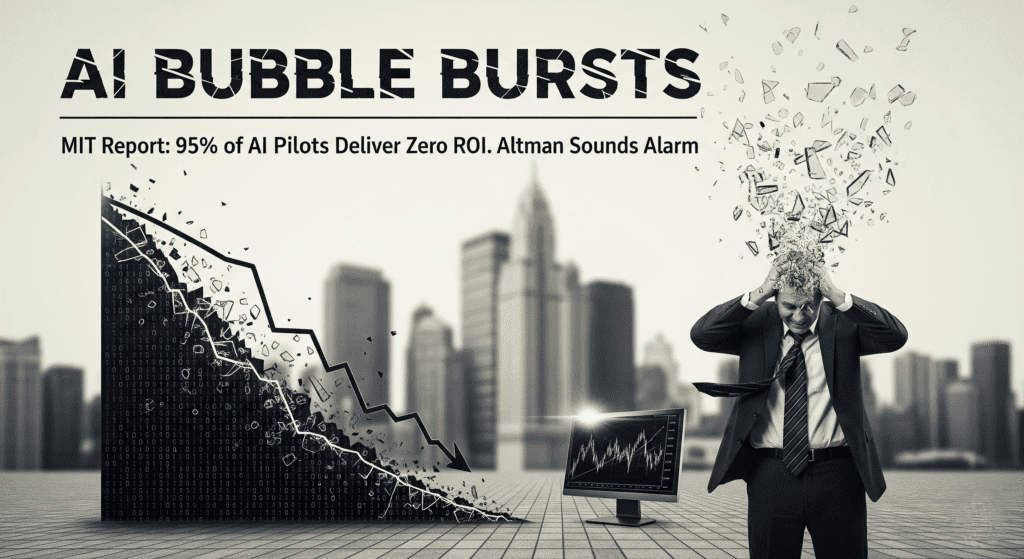By The Milk News Desk
California – August 20, 2025
US tech stocks tumble as AI Boom crashes into reality—MIT’s bombshell report exposes 95% of generative AI pilots delivering zero ROI, while OpenAI’s Sam Altman sounds the alarm on a brewing bubble that could scorch enthusiastic AI investors.

The Whispers of a Bubble: Altman’s Caution and MIT’s Cold Hard Data
The air crackled with unease this week as two significant developments cast a long shadow over the seemingly unstoppable AI juggernaut. First, the visionary behind OpenAI, Sam Altman, offered a stark warning that resonated deeply within the financial community. Drawing an unsettling parallel to the infamous dot-com bubble of the late 1990s, Altman suggested that the current AI frenzy might be inflating a similar speculative bubble. His words, coming from a figure at the epicenter of AI innovation, served as a potent reminder that even the most transformative technologies are not immune to the perils of irrational exuberance.
Adding fuel to the fire, a new study from the prestigious Massachusetts Institute of Technology (MIT) delivered a sobering dose of reality. The research revealed a startling statistic: a staggering 95% of companies investing in generative AI are, at present, seeing no returns on their investments. While the study was quick to attribute these failures to corporate ‘learning gaps’ and flawed integration rather than the inherent quality of AI models, the message was clear: the path to commercial viability for generative AI is far more complex and arduous than many investors had perhaps envisioned. This data point, stark and undeniable, challenged the prevailing narrative of immediate, widespread profitability, forcing a re-evaluation of the sector’s near-term prospects.
The Market’s Tremor: Nvidia, Palantir, and the Nasdaq’s Dip
The market’s response was swift and decisive. Major tech players, whose valuations had soared on the wings of AI enthusiasm, experienced significant pullbacks. Nvidia, a chipmaking titan often seen as the bellwether for AI hardware, saw its stock dip by 3.5%. Palantir, a data analytics firm with deep ties to AI applications, fared even worse, plummeting nearly 10%. The broader Nasdaq Composite, heavily weighted with technology stocks, registered a 2.2% decline over two days, marking its steepest fall since early August.
This sudden downturn ignited a flurry of discussion among financial analysts and strategists. Was this the beginning of a larger correction, or merely a healthy recalibration? Christopher Vecchio, Head of Futures & Forex at tastytrade, suggested that investors were paring back risk ahead of the Fed’s Jackson Hole meeting, with fresh concerns over the durability of the AI boom adding to the pressure. He noted a potential ‘classic defensive’ posturing, with money shifting towards bonds, gold, healthcare, and consumer staples.
Art Hogan, Market Strategist at B. Riley Wealth Management, echoed the sentiment of a necessary breather. He pointed out that technology stocks had surged 40% from their April lows, suggesting the group had gotten ‘ahead of itself.’ Hogan also highlighted the possibility of a rotation into other sectors, especially if the Federal Reserve signals a rate cut, making other investments more attractive. Michael Ashley Schulman, Chief Investment Officer at Running Point, described the tech stock swoon as ‘multiple compression meeting a little margin math,’ but acknowledged the timing made it hard to ignore the ‘new elephant in the server room’—the growing skepticism around AI’s immediate returns.
Beyond the Hype: A Deeper Look at Valuation and Long-Term Prospects
The recent sell-off isn’t just about a few bad headlines; it’s a symptom of deeper questions surrounding valuation and the pace of AI’s integration into the real economy. Torsten Slok, Chief Economist at Apollo Global Management, has even argued that the AI surge could eclipse the internet bubble of the 1990s, pointing to the fact that the 10 largest companies in the S&P 500 are now more overvalued relative to fundamentals than they were at the height of the dot-com era. This perspective suggests that the current market jitters are not just about AI’s immediate returns, but about the broader sustainability of current tech valuations.
However, it’s crucial to distinguish between short-term market fluctuations and long-term technological trends. While the immediate commercial returns for generative AI might be elusive for many companies, the transformative potential of AI remains undeniable. As Wedbush’s Dan Ives put it, “We are still in the early days of the AI revolution as the use cases are just starting to massively expand.” This sentiment is shared by many who believe that despite the current anxieties, money will eventually flow back into the tech sector as AI’s true value becomes more apparent and its applications mature.
Interestingly, the impact of this market tremor wasn’t uniform across the globe. Chinese tech giants like Alibaba and Tencent barely registered a dip, and SMIC, China’s chipmaking champion, even saw a 3% pop. This regional divergence suggests that market sentiment and the pace of AI integration might vary significantly across different economies, offering a nuanced perspective on the global AI landscape.
The Road Ahead: Navigating the AI Investment Landscape
The recent turbulence in US tech stocks serves as a vital reminder that even the most promising technological revolutions are subject to market cycles and investor sentiment. The warnings from figures like Sam Altman and the findings of the MIT study have injected a healthy dose of realism into the AI narrative, prompting investors to scrutinize not just the potential, but also the practicalities and profitability of AI investments.
For finance industry professionals, this moment presents both challenges and opportunities. It’s a time to re-evaluate portfolios, stress-test assumptions, and perhaps, to look beyond the immediate hype to identify companies that are not just dabbling in AI, but are genuinely integrating it to drive sustainable value. The AI boom is far from over, but the rules of engagement are evolving. The coming months will likely see a more discerning market, rewarding those who can demonstrate tangible returns from their AI endeavors, and punishing those who have ridden the wave of speculation without a clear path to profitability. The future of AI is still bright, but the path to realizing its full potential will undoubtedly be marked by both innovation and, at times, uncomfortable market corrections.
[ Written by Finance Journalists and used web Sources with AI Assistant]
